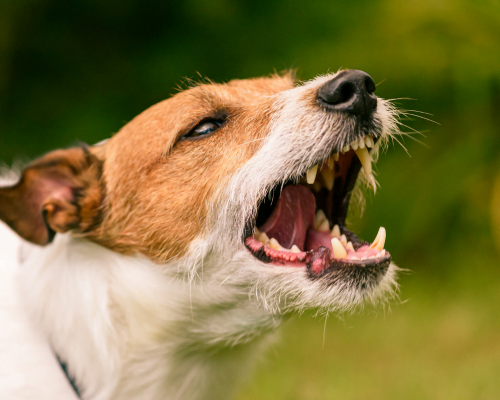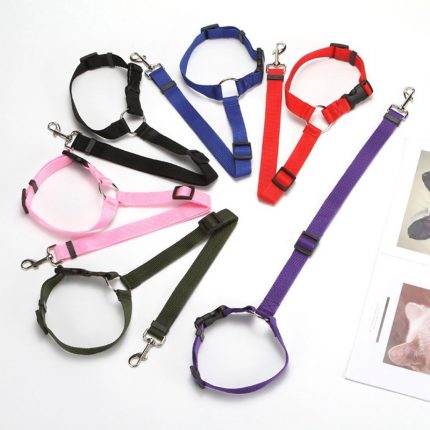Why Do Dogs’ Hair Stand Up When Barking?
Dogs are fascinating creatures with a wide range of behaviors that never cease to captivate us. One such behavior that often catches our attention is when a dog’s hair stands up while barking. It is a visual cue that can be both intriguing and slightly intimidating. But what exactly causes this peculiar phenomenon?
To understand why a dog’s hair stands up when barking, we must delve into the intricate world of canine communication and physiology. Dogs use various means to express themselves, including body language, vocalizations, and even the positioning of their fur. The phenomenon of hair standing up, technically known as piloerection, plays a significant role in their communication repertoire.
Piloerection is an involuntary response triggered by the sympathetic nervous system. It occurs in response to various stimuli, such as fear, excitement, aggression, or even arousal. When a dog barks, especially in intense situations, their sympathetic nervous system kicks in, causing the tiny muscles at the base of each hair follicle to contract. This contraction leads to the hair standing up, making the dog appear larger and more intimidating to potential threats.

The primary purpose behind this physiological response is to communicate dominance, assertiveness, or a warning to other animals or individuals. By making themselves look bigger and more formidable, dogs hope to deter potential confrontations or establish their position in a social hierarchy. It is an instinctual behavior deeply rooted in their evolutionary history as pack animals.
It is important to note that not all dogs exhibit piloerection while barking. The intensity and frequency of this response vary among individuals and can depend on factors such as breed, temperament, and previous experiences. Some dogs may display a more pronounced piloerection, while others may exhibit a milder response or none at all.
Understanding why a dog’s hair stands up when barking can help us interpret their behavior more accurately. It serves as a valuable insight into their emotional state and intentions. However, it is essential to consider other accompanying cues, such as body posture, tail position, and vocalizations, to form a comprehensive understanding of a dog’s communication.
In the following sections, we will explore further aspects of this fascinating topic. We will delve into the science behind piloerection, examine its relationship with different emotions, and discuss practical recommendations for dog owners to better understand and respond to their furry companions. So, let’s embark on this journey to unravel the mystery behind why dogs’ hair stands up when barking.
The Science Behind Dogs’ Hair Standing Up When Barking
Dogs have a remarkable ability to communicate through a combination of body language, vocalizations, and even the positioning of their fur. When dogs bark, it is not uncommon to notice their hair standing up, which adds an extra dimension to their communication. In this section, we will explore the science behind why dogs’ hair stands up when barking.
Piloerection: The Mechanism Behind It
The phenomenon of a dog’s hair standing up is known as piloerection. It occurs due to the contraction of tiny muscles called arrector pili, located at the base of each hair follicle. When a dog barks, especially in intense situations, the sympathetic nervous system is activated, triggering the contraction of these muscles. As a result, the hair follicles are pulled upright, causing the hair to stand on end.
The purpose behind this physiological response is rooted in the dog’s evolutionary history. Dogs are descendants of wolves, which were pack animals. In the wild, wolves use piloerection to appear larger and more intimidating when facing potential threats or during social interactions within the pack. By making themselves look more formidable, they aim to establish dominance, assertiveness, or send a warning signal to others.
The Role of Emotions
Piloerection in dogs is closely linked to their emotional state. It can be triggered by various emotions, including fear, excitement, aggression, or arousal. When a dog feels threatened or fearful, the sympathetic nervous system is activated, leading to piloerection as a defensive response. On the other hand, when a dog is excited or aroused, such as during play or anticipation of a reward, the same physiological mechanism can be observed.
It is important to note that different dogs may exhibit varying degrees of piloerection. Some dogs may have a more pronounced response, with their hair standing up prominently, while others may have a milder or less noticeable reaction. Factors such as breed, temperament, and individual experiences can influence the intensity of the piloerection response.
Interpreting Dogs’ Communication
Understanding why a dog’s hair stands up when barking can provide valuable insights into their communication. It serves as an indication of the dog’s emotional state and intentions. When a dog’s hair is standing up, it is a sign that they are experiencing heightened emotions and may be prepared to defend themselves or assert their dominance.
However, it is crucial to consider other accompanying cues to accurately interpret a dog’s communication. Body posture, tail position, facial expressions, and vocalizations all play a role in conveying a dog’s message. A combination of these signals provides a more comprehensive understanding of their current state and intentions.

Conclusion
In conclusion, understanding why dogs’ hair stands up when barking offers fascinating insights into their emotional and physical responses. For more detailed explorations on canine behavior and tips on managing your pet’s reactions, visit geepets.com. This website provides a wealth of information on dog care, behavior, training, and health.
Additionally, for further reading on canine communication and the science behind their body language, the American Kennel Club (akc.org) is an excellent resource. Both of these websites can serve as valuable tools for pet owners seeking to deepen their understanding of their furry companions and foster a harmonious living environment.
Practical Recommendations for Understanding Dogs’ Hair Standing Up When Barking
Understanding why dogs’ hair stands up when barking can provide valuable insights into their emotions and intentions. Here are some practical recommendations to help you better understand and respond to this behavior:
1. Observe and Familiarize Yourself with Your Dog’s Body Language
Every dog is unique, and their body language can vary significantly. Spend time observing your dog’s behavior in different situations, especially when they are barking. One intriguing aspect you might notice is why do dogs’ hair stand up when barking. This phenomenon, known as piloerection, can be a critical element to watch for. Take note of their overall body posture, tail position, facial expressions, and any signs of piloerection, which directly relates to the question of why do dogs’ hair stand up when barking.
By familiarizing yourself with your dog’s body language, including understanding why do dogs’ hair stand up when barking, you can better interpret their communication cues. The occurrence of piloerection, which prompts the question of why do dogs’ hair stand up when barking, is particularly telling. It’s often a sign of strong emotional reactions such as excitement, aggression, or fear. Observing this and other body language signs in context can help you understand the nuances of your dog’s emotional state and communication, shedding light on the question of why do dogs’ hair stand up when barking.
2. Consider the Context and Triggering Factors
When you observe your dog’s hair standing up while barking, it’s crucial to delve into the question: Why do dogs’ hair stand up when barking? Consider the context and triggering factors behind this behavior. Is your dog feeling threatened, fearful, excited, or aroused? Understanding the underlying emotions behind why dogs’ hair stand up when barking can help you respond appropriately. If your dog is fearful, providing a calm and reassuring environment is key.
On the other hand, if they are excited, engaging in positive activities to channel their energy can be beneficial. The phenomenon of why dogs’ hair stand up when barking is often linked to their emotional state and can serve as a signal to their human companions about how they are feeling. By addressing the root cause of why dogs’ hair stand up when barking, whether it’s fear, excitement, or arousal, you can tailor your response to meet your dog’s needs effectively.
3. Avoid Punishment or Aggressive Responses
Piloerection, a phenomenon often questioned as “Why do dogs’ hair stand up when barking?”, is a natural response and should not be punished or met with aggression. It’s crucial to understand that when you observe “Why do dogs’ hair stand up when barking?”, it’s simply your dog displaying a physiological reaction, often associated with emotions such as fear, excitement, or anxiety. Responding harshly to your dog’s piloerection, especially when pondering “Why do dogs’ hair stand up when barking?”, can exacerbate their fear or anxiety, leading to further behavioral issues.
Instead of punishment, when you notice your dog’s hair standing up, which might lead you to ask “Why do dogs’ hair stand up when barking?”, it’s important to provide a safe and supportive environment. Use positive reinforcement techniques to encourage desired behaviors, acknowledging that “Why do dogs’ hair stand up when barking?” is part of their natural reaction to certain stimuli. By focusing on positive reinforcement rather than punishment when faced with the question “Why do dogs’ hair stand up when barking?”, you can help your dog feel more secure and less inclined to react with fear or aggression.
4. Seek Professional Advice if Needed
If you are uncertain about your dog’s behavior, particularly if you’re wondering, “Why do dogs’ hair stand up when barking,” or need further guidance on this specific issue, it’s advisable to seek professional advice from a certified dog behaviorist or trainer. They can assess your dog’s specific situation, including the reasons behind the question, “Why do dogs’ hair stand up when barking?” This tailored approach allows them to provide recommendations that directly address your concerns, including a deeper understanding of “Why do dogs’ hair stand up when barking?”
Furthermore, a professional can help you address any underlying issues that may be contributing to the piloerection response, which is essentially what you’re observing when pondering, “Why do dogs’ hair stand up when barking?” Their expertise can offer insights into this behavior, ensuring that you’re well-equipped to manage and understand the nuances behind the question, “Why do dogs’ hair stand up when barking?”

5. Create Positive Associations
If your dog’s piloerection, a phenomenon where you might wonder, “Why do dogs’ hair stand up when barking,” is triggered by fear or anxiety, it’s crucial to work on creating positive associations with the triggering stimuli. Gradually expose your dog to the feared situation or object, which could make you question, “Why do dogs’ hair stand up when barking?” While doing so, provide treats, praise, and reassurance to help them feel safe and secure.
This process, known as desensitization and counterconditioning, can help your dog develop a more positive response to situations that previously made you ask, “Why do dogs’ hair stand up when barking?” By understanding the root of the question, “Why do dogs’ hair stand up when barking,” and addressing it through these techniques, you can help your dog feel more relaxed and less likely to exhibit this stress-induced reaction.
Our featured products:
6. Focus on Building Trust and Confidence
Building trust and confidence in your dog is crucial for their overall well-being. Engage in regular training sessions, provide mental and physical stimulation, and offer rewards for good behavior. By building a strong bond based on trust and positive reinforcement, you can help your dog feel more secure and reduce the likelihood of piloerection in stressful situations.
Remember, each dog is unique, and what works for one may not work for another. Patience, consistency, and understanding are key when addressing any behavioral concerns. By implementing these recommendations and seeking professional guidance when needed, you can create a harmonious and supportive environment for your furry companion.















